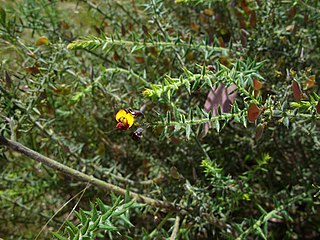
Daviesia arenaria, commonly known as sandhill bitter-pea, is a species of flowering plant in the family Fabaceae and is endemic to south-eastern continental Australia. It is usually a hummock-forming shrub with many short, spiny branchlets and heart-shaped to elliptic phyllodes with a sharp point on the end, and orange-pink, maroon and yellow flowers.

Daviesia debilior is a species of flowering plant in the family Fabaceae and is endemic to the south-west of Western Australia. It is a shrub with low-lying stems and many erect branchlets, scattered linear to scale-like phyllodes, and yellow, purplish, orange-pink and dark purplish flowers.

Daviesia emarginata is a species of flowering plant in the family Fabaceae and is endemic to the south-west of Western Australia. It is an erect, mostly glabrous shrub with scattered egg-shaped phyllodes with the narrower end towards the base and with a notch at the tip, and yellow and pink flowers.

Daviesia laevis is a species of flowering plant in the family Fabaceae and is endemic to the Grampians in Victoria, Australia. It is an open, erect shrub with arching branchlets, scattered narrow elliptic to linear phyllodes and orange-yellow and brownish-red flowers.

Daviesia major is a species of flowering plant in the family Fabaceae and is endemic to the south-west of Western Australia. It is an erect, many-stemmed shrub with scattered, erect, sharply-pointed, cylindrical phyllodes and orange and red flowers.

Daviesia oxyclada is a species of flowering plant in the family Fabaceae and is endemic to the south-west of Western Australia. It is a densely-branched, glabrous shrub with spiny stems, vertically compressed, triangular phyllodes with the narrower end towards the base, and yellow or orange flowers with red markings.
Daviesia pleurophylla is a species of flowering plant in the family Fabaceae and is endemic to a restricted area in the north of Western Australia. It is a large, openly-branched shrub with many ribbed branchlets, scattered, sharply-pointed, needle-shaped phyllodes, and yellow and dark red flowers.

Daviesia pubigera is a species of flowering plant in the family Fabaceae and is endemic to New South Wales. It is an open to spreading shrub with sharply-pointed, narrowly egg-shaped phyllodes, and yellow and red flowers.
Olearia fluvialis is a species of flowering plant in the family Asteraceae and is endemic to inland areas of northern Western Australia. It is a shrub with scattered, narrowly egg-shaped leaves, and white or mauve and yellow, daisy-like inflorescences.

Daviesia ramosissima is a species of flowering plant in the family Fabaceae and is endemic to the south-west of Western Australia. It is a shrub with many branchlets, scattered, needle-like, sharply pointed phyllodes and orange-yellow and red flowers.

Daviesia rhizomata is a species of flowering plant in the family Fabaceae and is endemic to the south-west of Western Australia. It is a low, rhizome-forming shrub with tangled branchlets, scattered, needle-like, sharply pointed phyllodes, and yellow and red flowers.

Daviesia sejugata is a species of flowering plant in the family Fabaceae and is endemic to southern Australia. It is a straggling, mostly glabrous shrub with spiny, ridged branchlets, scattered, sharply-pointed, narrowly elliptic phyllodes, and yellow, maroon, orange and dark purple flowers.
Daviesia umbonata is a species of flowering plant in the family Fabaceae and is endemic to the south-west of Western Australia. It is a bushy, openly-branched shrub with narrowly elliptic to narrowly egg-shaped, sharply pointed phyllodes and yellow and red flowers.

Daviesia uncinata is a species of flowering plant in the family Fabaceae and is endemic to the south-west of Western Australia. It is a densely-branched shrub with many stems, hooked, needle-shaped, sharply pointed phyllodes continuous with the branchlets and rich yellow and pinkish-red flowers.
Mirbelia balsiformis is a species of flowering plant in the family Fabaceae and is endemic to the far west of Western Australia. It is an erect to sprawling shrub with leaves reduced to triangular scales, and yellow to orange and red flowers arranged in racemes on the side of the branchlets.
Mirbelia corallina is a species of flowering plant in the family Fabaceae and is endemic to the far west of Western Australia. It is a slender, sprawling sub-shrub with a few narrowly elliptic to narrowly egg-shaped leaves and pink and yellow flowers arranged in racemes near the ends of the branchlets.
Mirbelia ferricola is a species of flowering plant in the family Fabaceae and is endemic to inland parts of the south-west of Western Australia. It is an erect shrub with leaves reduced to small scales, and red and yellow flowers arranged in racemes at the ends of the branches.
Mirbelia rhagodioides is a species of flowering plant in the family Fabaceae and is endemic to inland areas of Western Australia. It is an erect, prickly shrub with clustered linear or narrowly elliptic leaves and yellow and red flowers.
Mirbelia stipitata is a species of flowering plant in the family Fabaceae and is endemic to inland areas of Western Australia. It is a spiny, more or less leafless shrub with yellow and red flowers.
Cryptandra graniticola is a flowering plant in the family Rhamnaceae and is endemic to southern Western Australia. It is an upright, spreading shrub with spiny branchlets, linear to narrowly egg-shaped leaves and clusters of white, tube-shaped flowers.











